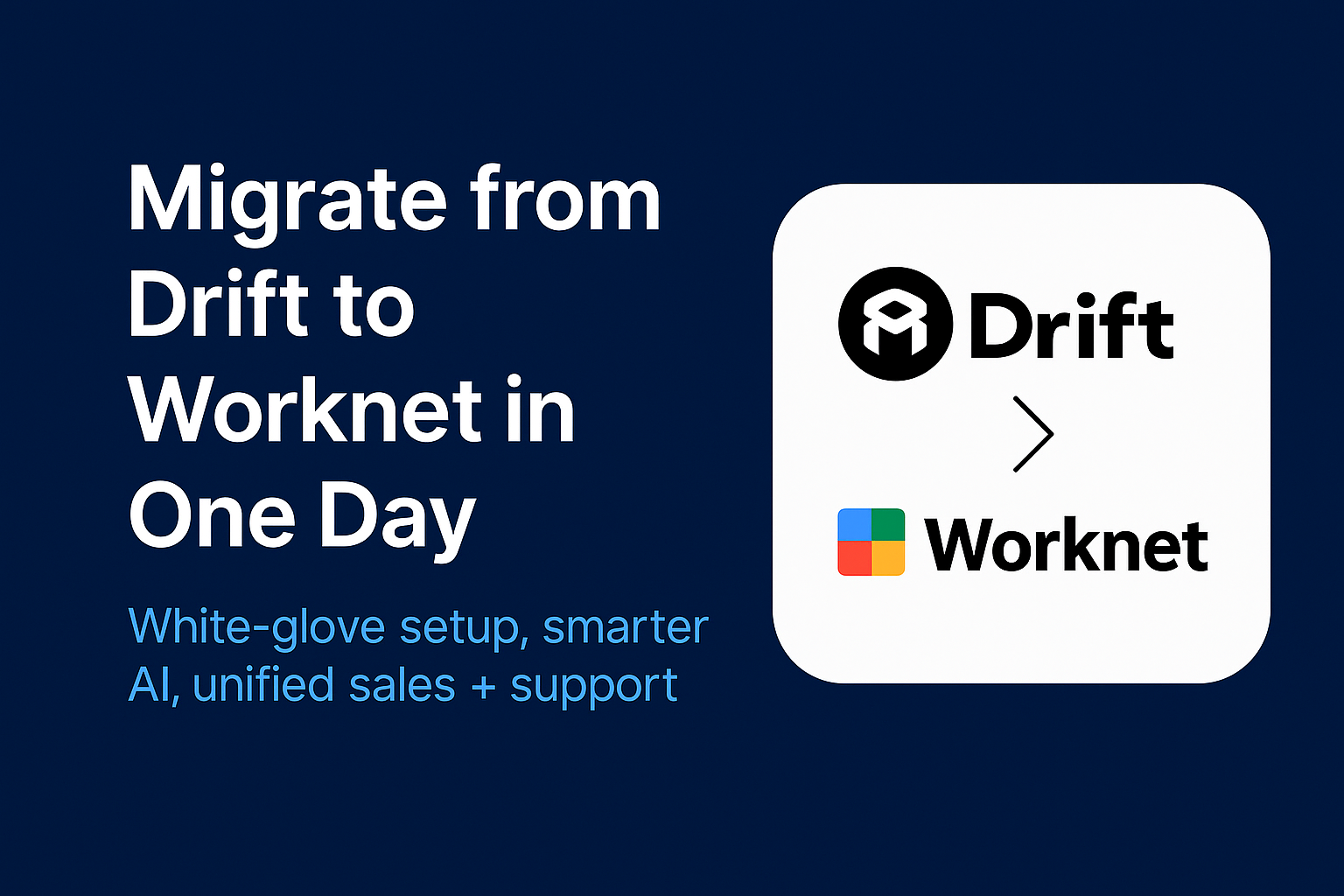Mastering Customer Experience Personalization
Think about your favorite local spot—maybe a coffee shop or a small bookstore—where they know you by name and remember your preferences. That feeling of being recognized and genuinely understood? That's the essence of customer experience personalization. It's the craft of making every interaction, every product recommendation, and every piece of communication feel like it was created just for that one individual. This guide will walk you through why personalization is critical and how to implement it effectively.
Why Personalization Is No Longer Optional
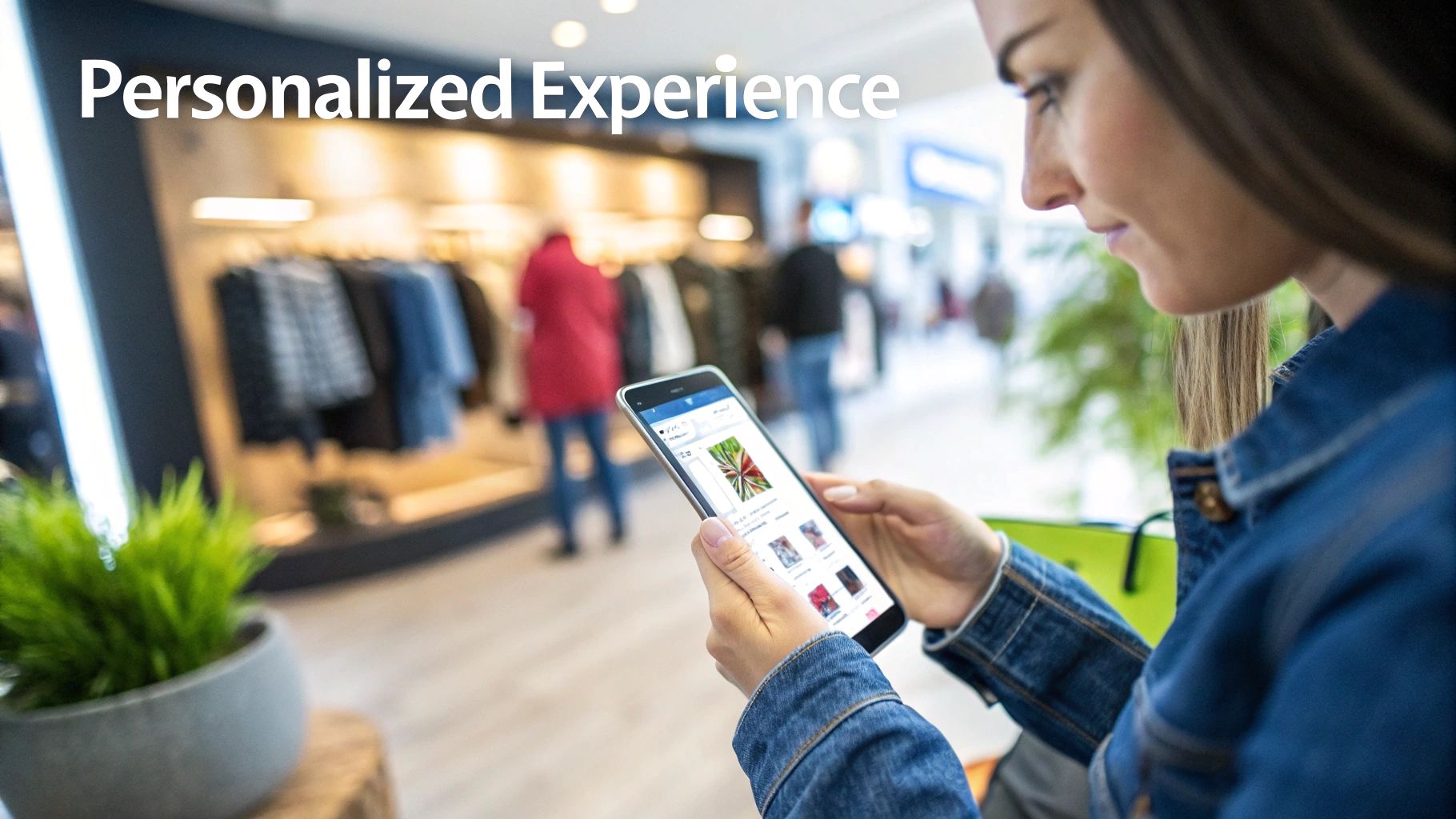
In today's crowded market, personalization has evolved from a "nice-to-have" marketing tactic into a core business strategy. We've moved far beyond simply dropping a first name into an email. True personalization means architecting a uniquely relevant journey for every person who interacts with your brand. This deeper connection is what separates the companies that thrive from those that just get by.
At its heart, personalization is a critical piece of the larger customer experience optimization puzzle. When you understand and even anticipate what your customers need, you build a powerful competitive edge that isn't just about having the lowest price or the most features. Instead, your advantage comes from making people feel truly seen.
The New Competitive Battlefield
The rules of business have changed. Competing on price alone is a race to the bottom, and feature-for-feature battles have diminishing returns. Today's consumers care more about how a brand makes them feel, and the data backs this up. The fight for market share is now being won or lost based on the quality of the customer experience.
By 2025, an estimated 89% of businesses expect to compete primarily on the basis of customer experience. This isn't a trend driven by boardrooms; it's a direct response to consumer behavior. Research shows a staggering 80% of consumers are more likely to buy from companies that provide personalized experiences.
The message for businesses is loud and clear: adapt to these new expectations or risk being left behind.
Personalization is the most effective way to show customers you're listening. It turns a generic, one-way broadcast into a meaningful, two-way conversation. That dialogue builds a foundation of trust and loyalty that competitors find nearly impossible to break.
The statistics speak for themselves, painting a clear picture of why personalization has become a top priority for businesses aiming for growth and customer retention.
The Business Impact of Personalization at a Glance
These numbers highlight a fundamental shift. Investing in personalization isn't just about improving metrics; it's about aligning your business with modern consumer expectations to drive real, sustainable growth.
Translating Personalization into Business Growth
The benefits of a smart personalization strategy aren't just theoretical—they show up on the bottom line. When customers see relevant recommendations, find helpful content right when they need it, and get timely support, they stick around and spend more.
This leads to several clear advantages:
- Stronger Customer Loyalty: Feeling understood creates a powerful bond, which means customers are less likely to churn and more likely to make repeat purchases.
- Higher Customer Lifetime Value (CLV): Personalized upselling and cross-selling are far more effective because they're relevant, encouraging customers to spend more over their entire relationship with you.
- Increased Revenue and Conversions: By tailoring your website, offers, and messaging to individual user behavior, you can see a significant lift in conversion rates and average order value.
Ultimately, putting resources into customer experience personalization is an investment in a more profitable and sustainable future. It’s a shift from simply processing transactions to building genuine, lasting relationships.
Building Your Personalization Strategy Blueprint
A great personalization strategy doesn't just happen. It’s not about luck or guessing what customers want; it's a deliberate plan built on a few core principles. Think of it as moving from shouting at a crowd to having a meaningful, one-on-one conversation with each person—but at scale. The whole thing starts with truly understanding who your customers are and what they need, then using that insight to act.
You wouldn't start building a house without a blueprint, right? The same logic applies here. Your personalization efforts need a solid framework to make sure everything works together, from the data you collect to the final experience you deliver to a customer. A great starting point for thinking about this is a solid guide to improve customer engagement, which really drives home the importance of data.
Pillar 1: Unifying Customer Data
First things first: you have to get all your customer data in one place. Right now, it's probably scattered everywhere—your CRM, website analytics, help desk tickets, email marketing tool, you name it. To build any kind of coherent personalization, you need to pull all those puzzle pieces together into a single, unified customer profile.
This unified view becomes your single source of truth. It stitches together different data points to paint a complete picture of each person you're talking to. The infographic below shows the kind of data that forms this foundation.
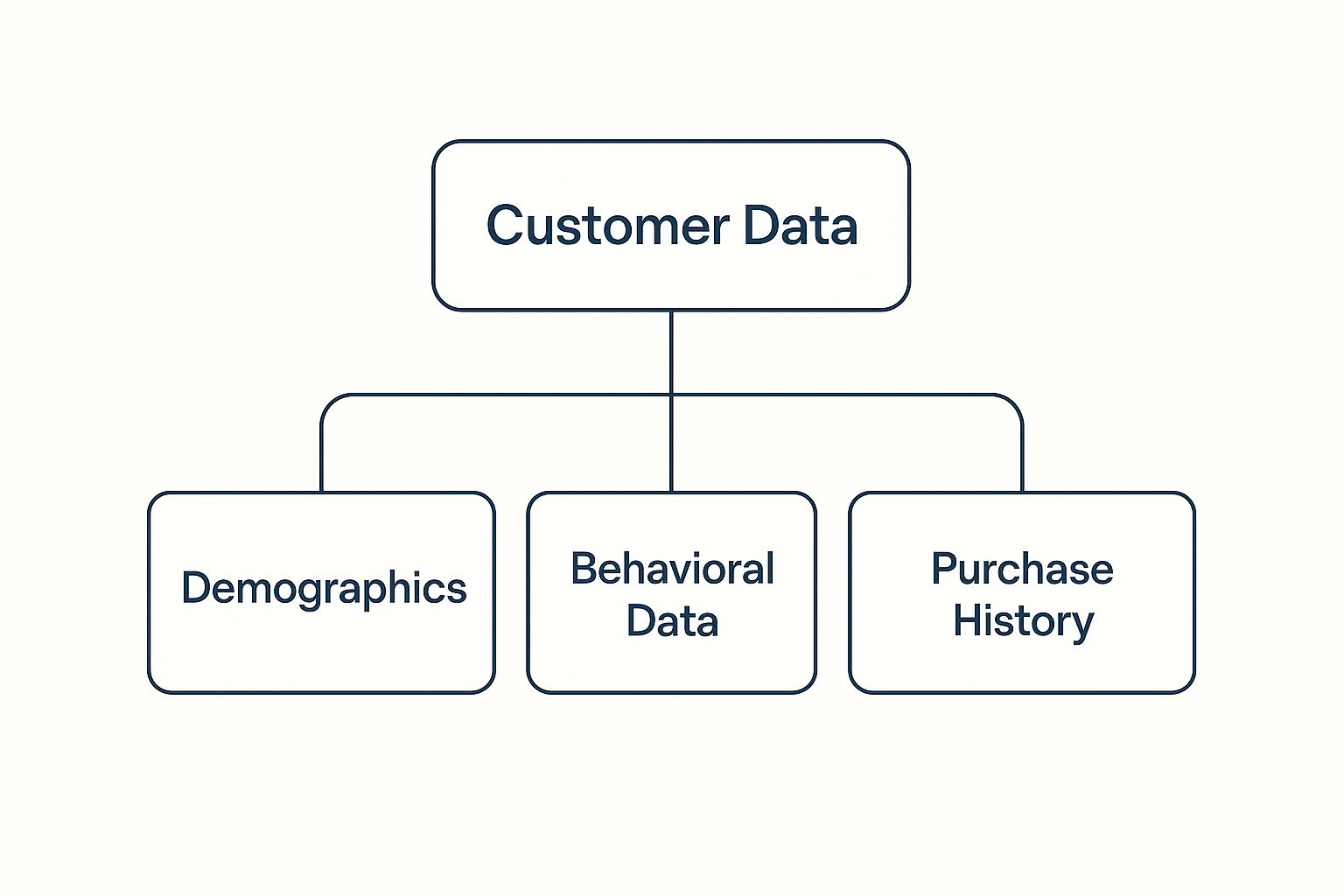
As you can see, a truly holistic view combines demographics with actual behaviors and purchase history. Getting this part right is the bedrock of everything else you'll do.
Pillar 2: Intelligent Segmentation
Once your data is tidy and in one spot, it's time for intelligent segmentation. This is way more sophisticated than just grouping people by age or location. We're talking about creating dynamic segments based on what people actually do—their behaviors, their interests, and where they are in their buying journey.
For instance, instead of one giant "new user" bucket, you can get much more specific:
- High-Intent Visitors: People who have checked out your pricing page three times or spent a ton of time on a specific feature page.
- Cart Abandoners: The classic group who loaded up a cart but got distracted before checking out.
- Loyal Advocates: Your best customers—the ones who buy repeatedly and even leave you glowing reviews.
This level of detail is what allows you to tailor your messaging with laser precision. It makes every interaction feel relevant.
Pillar 3: Customizing Content and Offers
With your data unified and your segments defined, now comes the fun part: customizing the actual experience. This is where personalization becomes real and tangible for your customers. It’s all about dynamically swapping out content, offers, and product recommendations based on a user's segment or individual profile.
Research shows that 45% of consumers are more likely to shop on a site that offers personalized recommendations. That's a direct line between smart customization and actual sales.
But good customization isn't just about showing different products. It's about adapting the entire journey. A first-time visitor might get a pop-up with a 10% welcome discount, while a loyal customer might see recommendations based on their last five purchases. You're meeting them where they are.
Pillar 4: Strategic Delivery and Optimization
The final piece of the puzzle is delivering these personalized experiences on the right channel at the right time—and constantly tweaking your approach to make it better. Your strategy needs to be omnichannel, so the experience feels consistent whether someone is on your website, opening an email, or chatting with your support bot.
This means you’re always asking a few key questions:
- Which channel works best for this message? Is it an email, a push notification, or an in-app prompt?
- When is the perfect time to send it? When is this person most likely to pay attention?
- How can we do better next time? What are our A/B tests telling us about what works and what doesn't?
This constant cycle of delivery, measurement, and optimization is what separates a good personalization strategy from a great one. It keeps your efforts sharp and ensures you're adapting as your customers' behaviors change over time.
Turning Customer Data into Actionable Insights
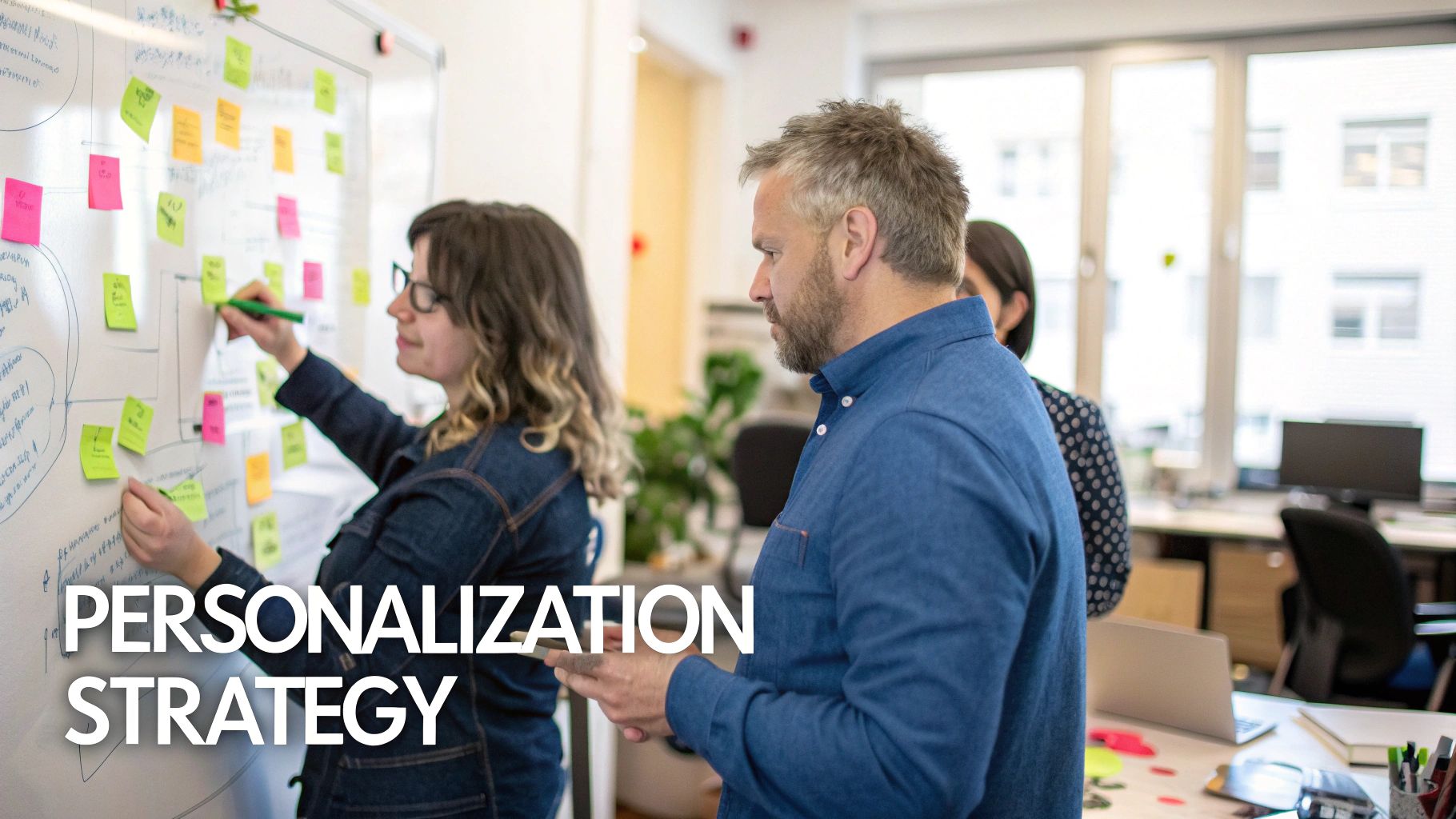
Any effective customer experience personalization strategy is built on a foundation of data. Think of data as the fuel for your personalization engine—without a steady supply of high-quality fuel, even the most powerful engine will sputter and fail. But not all data is created equal, and knowing the difference is the first step toward building a system that truly connects with your customers.
The goal here isn't just to collect data, but to understand the human being behind those data points. By weaving together different information sources, you can turn abstract numbers into a rich, three-dimensional view of your customer. This lets you anticipate their needs and create experiences that feel genuinely helpful and relevant—the core of a hyper-personalized customer experience.
The Three Core Types of Customer Data
To build a complete customer profile, you need to pull from three distinct categories of data. Each one provides a different layer of insight, and when combined, they form a powerful picture of who your customer is and what they want.
Zero-Party Data: This is information that customers intentionally and proactively share with you. Think of it as what they tell you directly. It includes their preferences from a welcome quiz, answers to a survey, or settings they select in their account profile. This data is gold because it's explicit, accurate, and comes straight from the source.
First-Party Data: This is the data you gather yourself as customers interact with your brand across your own platforms. It’s what you observe about their behavior. Examples include their purchase history, which pages they visit on your website, items they add to a cart, or how long they watch a video. It's incredibly valuable because it reflects genuine interest and real actions.
Third-Party Data: This is aggregated data you can purchase from external sources that don't have a direct relationship with your customers. It often includes broad demographic details like income brackets, general interests, or major life events. While it can help enrich existing profiles, its use is declining as the industry moves toward greater privacy and transparency.
By weaving these data types together, a simple customer profile can evolve into a detailed, actionable story.
The Challenge of Unifying Disparate Data
For most businesses, the biggest obstacle isn't a lack of data; it's that their data is trapped in separate, disconnected systems. Your customer information is likely scattered all over the place: your CRM has sales conversations, your website analytics track browsing habits, and your help desk logs support tickets.
Imagine trying to understand a person by only looking at one of these sources. You’d get a flat, incomplete, and often misleading picture.
The real magic happens when you break down these data silos. By creating a unified customer view, you stitch together every touchpoint into a single, chronological timeline. This is how you start personalizing the entire journey, not just isolated interactions.
Achieving this unified view usually means bringing in a Customer Data Platform (CDP) or similar technology to act as a central hub. This hub pulls in data from all your tools, cleans and organizes it, and builds a comprehensive profile for each user that your personalization systems can then use.
Balancing Personalization with Privacy and Trust
In the rush to gather data-driven insights, we can't forget there's a real person on the other side of the screen. People are more aware than ever of how their data is being used, and they rightfully demand transparency and control. This isn't a roadblock to personalization—it's an opportunity to build trust.
The key is to create a clear value exchange. When customers understand why you're collecting data and see real benefits in return, they're much more willing to share it. In fact, one study found that 82% of consumers will share personal information to get a more personalized shopping experience, and 57% will spend more with brands that deliver it. When personalization adds clear value, customers actually welcome it.
Of course, complying with regulations like GDPR and CCPA is non-negotiable. But compliance should just be the starting line, not the finish line. The real goal is to foster a relationship built on mutual respect. Be upfront about your data practices, provide easy-to-use privacy controls, and always put the customer's best interests first. This ethical approach turns personalization from a potential risk into your most powerful tool for building loyalty.
How AI Is Revolutionizing Personalization
For a long time, personalization was based on simple "if-then" rules. If a customer buys a tent, you show them an ad for a sleeping bag. It worked, but it was basic. This kind of logic just can't keep up with how people actually shop and interact with brands today. Now, artificial intelligence (AI) and machine learning have completely flipped the script, moving us from reactive rules to genuinely proactive, predictive engagement.
Here’s a simple way to think about the difference. Old-school personalization might recommend a winter coat because it's December. AI-powered personalization recommends that same coat because it sees you've been browsing ski resorts, searching for flights to Colorado, and looking at travel blogs. It’s a massive step up in delivering true customer experience personalization.
From Rules-Based to Predictive Personalization
The real magic of AI is its ability to sift through enormous amounts of data in real-time and spot subtle patterns a human could never catch. This lets businesses get ahead of customer needs, sometimes before the customer is even fully aware of them. Instead of just reacting to what someone did yesterday, you can start shaping their experience tomorrow.
This predictive power is a game-changer across the customer journey:
- Predictive Product Recommendations: AI algorithms, like the ones behind Amazon and Netflix, don't just look at your history. They analyze the behavior of millions of similar users to suggest products or movies you're likely to love, even if you've never shown direct interest before.
- Dynamic Journey Orchestration: AI can instantly calculate the "next best action" for every single customer. It might decide to send a push notification with a timely offer to one person while holding back on another who seems less engaged, preventing them from getting annoyed and tuning you out.
- Hyper-Personalized Messaging: AI figures out which tone, timing, and channel work best for different people. It then automatically adjusts the communication. One customer might respond better to an informal email at 9 AM, while another prefers a professional in-app message in the evening.
This level of intelligence makes true one-to-one marketing a scalable reality, not just a nice idea. To see just how powerful this is, you can read our deep dive on using generative AI for customer experience.
The Driving Force Behind Modern Personalization
The shift to AI isn't just a passing trend; it's a fundamental business necessity. The projected growth in the customer experience and personalization software market shows just how much companies are betting on these technologies.
This growth reflects a clear market reality: companies that weave AI into their personalization efforts are pulling ahead of the competition.
The numbers speak for themselves. A staggering 92% of businesses are now using AI-driven personalization to fuel growth. The customer experience and personalization software industry is on track to hit $11.6 billion by 2026, a huge jump from $7.6 billion in 2021. You can see more in this report on personalization statistics.
These figures make it clear that AI isn't some far-off concept. It's the engine driving the most effective personalization strategies today.
AI in Action Across the Customer Lifecycle
AI’s impact isn’t limited to that first sale. It adds value at every single stage of the relationship, acting as an intelligent layer that makes every interaction—from the first click to long-term loyalty—smarter.
1. Real-Time Engagement and QualificationAn AI-powered chatbot on your website can do so much more than answer FAQs. It can analyze a visitor's on-site behavior in real-time to figure out what they're looking for, qualify them as a potential lead, and steer them toward the right content or product. It creates a seamless first impression.
2. Accelerating Trial ConversionFor SaaS companies, the trial period is everything. AI can watch how a trial user engages with the product, spot where they might be getting stuck, and proactively offer a helpful tip or tutorial right when they need it. This kind of personalized guidance helps people see the product's value faster, making them far more likely to become paying customers.
3. Boosting Retention and Uncovering ExpansionEven after the sale, AI is still working. It can handle support questions, recommend advanced features based on usage patterns, and even detect early warning signs that a customer might be thinking of leaving. This always-on, proactive support keeps customers happy and also uncovers natural opportunities to upsell or cross-sell, driving up customer lifetime value. By automating these interactions, AI frees up your team to focus on the big-picture, strategic work that really moves the needle.
Real-World Personalization Examples That Work
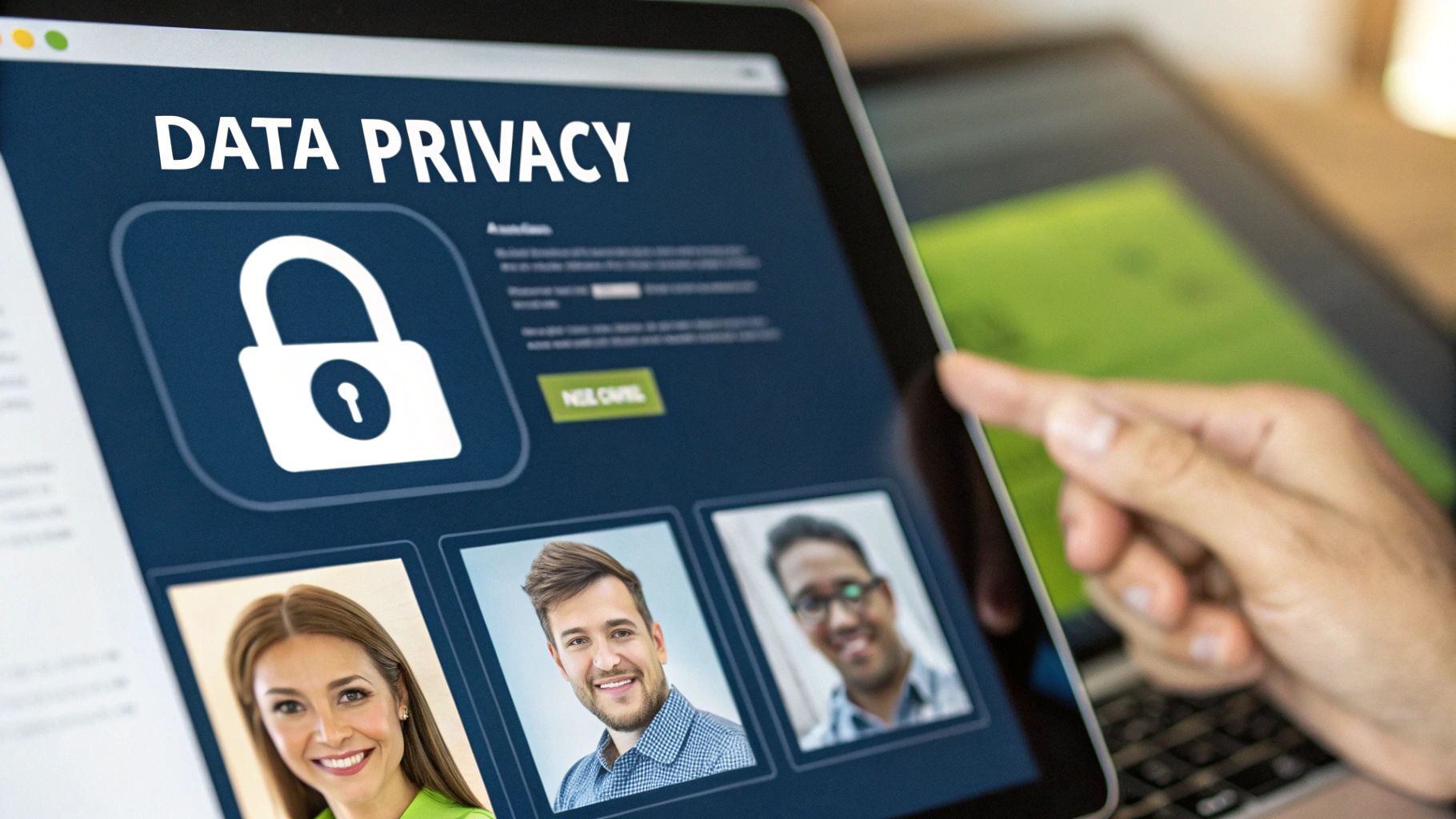
Theory is one thing, but seeing customer experience personalization in the wild is where it really clicks. To truly get a feel for its impact, let's look at how top companies are already putting these ideas into practice to create interactions that are both memorable and effective.
These examples prove that personalization isn't a rigid formula. It's a flexible approach that can be molded to fit any industry or customer touchpoint, from the e-commerce giants you shop with every day to the SaaS tools that run your business.
We'll dive into the specific strategies that make these examples shine—what data they're using, how they customize the journey, and the bottom-line results they're seeing.
E-commerce: Perfecting Product Discovery
For any online retailer, success boils down to a simple challenge: get the right product in front of the right person at the right time. The brands that nail this see a huge lift in both sales and customer loyalty. They manage to turn a massive, overwhelming catalog into a beautifully curated shopping trip.
The classic example here is, of course, Amazon. Its recommendation engine is legendary for good reason. By looking at everything from your past purchases and browsing history to what other shoppers like you have bought, Amazon builds a homepage that’s completely unique to you.
It’s not just a nice-to-have, either. One study found that 45% of consumers are more likely to shop on a site that offers personalized recommendations. That’s a straight line from smart personalization to more revenue.
Another great example comes from the sock brand Darn Tough. They pay close attention to customer behavior, like which sock categories someone browses (hiking vs. running vs. lifestyle), and use that info to tailor their emails and on-site suggestions. If you've been eyeing their hiking socks, you won’t get spammed with promotions for dress socks. It’s a simple but powerful way to make their marketing feel helpful, not annoying.
SaaS: Creating Frictionless Onboarding and Adoption
In the world of Software-as-a-Service (SaaS), the first few moments a new user spends with your product are absolutely critical. If they get lost, confused, or can't see the value right away, they're gone. This is where smart SaaS companies use personalization to guide users through that make-or-break trial period.
Think about a project management tool. A user who signs up and identifies as a "solo freelancer" needs a totally different introduction than someone who says they're part of a "50-person marketing team."
- The Freelancer: Should probably see a clean, simple dashboard and a quick tutorial on managing individual tasks.
- The Marketing Team Lead: Should be prompted to invite their colleagues right away and shown how to use collaborative features and reporting dashboards.
This kind of tailored onboarding helps users hit their "aha!" moment much faster, which dramatically increases the odds they’ll convert to a paid plan. The secret sauce is building strong customer communication strategies that adapt on the fly.
Travel and Hospitality: Crafting the Perfect Getaway
The travel industry is literally built on creating dream experiences, so it's a natural home for deep personalization. Netflix really set the standard here for media. Think about it: Netflix doesn't just have one product; it has over 100 million different products—a unique one for each user.
Travel companies are now embracing a similar mindset. By analyzing past searches, booking history, and even the time of year a user is browsing, they can dynamically change what's on offer.
Let's say a user previously booked a family-friendly beach resort in Mexico. The next time they visit that travel site, they won't be greeted with ads for a solo backpacking trip through Europe. Instead, the homepage will be filled with:
- Deals on family vacation packages.
- Content like "Top 10 All-Inclusive Resorts for Kids."
- Promotions for destinations with a similar vibe and activities.
This changes the platform from a basic booking tool into a trusted travel advisor. It builds a real, long-term relationship by showing it truly understands the customer's travel style.
Personalization Strategies Across Industries
As you can see, the why behind personalization is consistent—create better experiences—but the how varies quite a bit depending on the industry and its specific goals.
Ultimately, whether you're selling socks, software, or getaways, the goal is the same: be genuinely helpful and relevant. When you get that right, the business results follow.
A Practical Guide to Putting Your Program into Action
Alright, let's move from theory to reality. This is where the rubber meets the road in customer experience personalization. The good news? You don't need to boil the ocean or launch a massive, company-wide overhaul from day one. The smartest way to get started is to think small, score a quick win, and build momentum from there.
This final section is all about action. I'll walk you through a practical roadmap for getting your personalization efforts off the ground (or taking them to the next level). By following these proven steps, you can roll out a program that makes a real difference for your customers and your business.
Start Small With a High-Impact Use Case
The biggest mistake I see companies make is trying to do everything at once. Resist that urge. Instead, find one specific, high-impact area where personalization can deliver a clear, measurable victory. This approach keeps the risk low and helps you build an undeniable case for expanding your efforts later.
Where should you start? Here are a few great entry points:
- Abandoned Cart Emails: It's a classic for a reason. Personalize those follow-up emails with the exact items someone left behind. It's a simple, effective way to recover sales you would have otherwise lost.
- Welcome Series for New Users: Don't send every new subscriber the same generic message. Tailor their first few emails based on how they signed up or what they did first on your website or app.
- On-site Recommendations: Use a visitor's real-time browsing history to show them relevant product or content suggestions on your key pages.
By zeroing in on a single, well-defined goal, you make it much easier to execute perfectly and show stakeholders some tangible results right away.
Set Clear KPIs and Measure What Matters
To prove your personalization program is actually working, you have to look past vanity metrics like clicks and opens. You need to focus on Key Performance Indicators (KPIs) that connect directly to your core business goals. The right metrics will show you exactly how personalization is influencing customer behavior and, ultimately, your revenue.
A critical part of implementation is ensuring your back-end systems can support these dynamic experiences. For a comprehensive resource on implementing AI in your workflow, exploring seamless AI workflow automation is crucial for delivering personalized experiences at scale.
Make sure you're tracking metrics like these:
- Lift in Conversion Rate: How does the conversion rate for your personalized experience stack up against a non-personalized control group? This is your proof.
- Increase in Average Order Value (AOV): Are your personalized recommendations actually encouraging customers to add more to their cart?
- Reduction in Customer Churn: Is a more personalized onboarding and support experience keeping more customers around for the long haul?
Nurture a Culture of Testing and Optimization
Personalization isn't a "set it and forget it" project. Think of it as a continuous loop of testing, learning, and improving. You need to build a culture where A/B testing isn't an afterthought—it's just how things are done for every new initiative. This data-driven mindset ensures your decisions are based on evidence, not just educated guesses.
And just as importantly, you have to protect customer data to build trust. Be upfront about what information you collect and how you use it. Give users easy-to-find controls over their data. A personalization strategy built on a foundation of respect is the only kind that creates truly loyal, long-term customers.
Common Questions About Personalization
Even with a solid game plan, you're bound to run into questions when you start putting a customer experience personalization program into action. Getting ahead of these common sticking points can help you sidestep challenges and feel more confident in your strategy. Let's walk through some of the most frequent questions we hear.
Where Should a Small Business Start with Personalization?
The trick is to start small and aim for a quick win. Don't fall into the trap of thinking you need to personalize everything all at once. The best place to begin is with the data you already have—your own first-party data. Think about which pages a visitor has looked at or what they've put in their shopping cart on your site.
Use that information to create one or two simple customer segments. A fantastic first move is to set up a personalized email campaign for abandoned carts. Another easy win is welcoming new subscribers with content that's directly tied to the reason they signed up. Pick one high-impact area, measure the results closely, and then let what you learn guide your next steps.
What Is the Difference Between Personalization and Customization?
This one is easier to understand when you think about who’s in the driver's seat.
Customization is what happens when a user actively makes choices to shape their experience. Think about choosing "dark mode" in an app or rearranging the widgets on a dashboard. The user is telling the system exactly what they want.
Personalization is when the system does the heavy lifting for the user. It uses their behavior and data to make smart guesses. When Netflix suggests a new show because it knows what you've watched before, that's personalization in action. The system is proactively molding the experience for the user.
Both are incredibly useful, but personalization is driven by data and anticipates what someone needs before they even ask. It creates a much smoother, more intuitive experience because it doesn't wait for the user to make the first move.
How Do You Measure the ROI of a Personalization Strategy?
To get a real sense of your return on investment, you have to be disciplined about setting clear goals and tracking the right numbers. It's tempting to look at simple metrics like email open rates, but you need to go deeper and focus on what truly affects your revenue.
A/B testing is your best friend here. By comparing a personalized experience against a generic one (for a control group), you can directly connect any uplift in revenue or engagement to your efforts. Key metrics you should be watching include:
- Lift in Average Order Value (AOV): Are your personalized recommendations actually convincing people to buy more?
- Increase in Customer Lifetime Value (CLV): Are personalized experiences making customers more valuable over the long haul?
- Reduction in Churn Rate: Is a more relevant experience keeping customers from leaving?
- Higher Engagement Rates: Are people spending more time on your site or interacting with more content?
Ready to convert more visitors and grow customer lifetime value? Worknet.ai transforms how SaaS companies engage users with AI-powered chat that drives trial conversion, boosts retention, and uncovers expansion opportunities. See how we can personalize your customer journey at https://worknet.ai.
FAQs
.png)
Lorem ipsum dolor sit amet, consectetur adipiscing elit. Suspendisse varius enim in eros elementum tristique. Duis cursus, mi quis viverra ornare, eros dolor interdum nulla, ut commodo diam libero vitae erat. Aenean faucibus nibh et justo cursus id rutrum lorem imperdiet. Nunc ut sem vitae risus tristique posuere.
Lorem ipsum dolor sit amet, consectetur adipiscing elit. Suspendisse varius enim in eros elementum tristique. Duis cursus, mi quis viverra ornare, eros dolor interdum nulla, ut commodo diam libero vitae erat. Aenean faucibus nibh et justo cursus id rutrum lorem imperdiet. Nunc ut sem vitae risus tristique posuere.
Lorem ipsum dolor sit amet, consectetur adipiscing elit. Suspendisse varius enim in eros elementum tristique. Duis cursus, mi quis viverra ornare, eros dolor interdum nulla, ut commodo diam libero vitae erat. Aenean faucibus nibh et justo cursus id rutrum lorem imperdiet. Nunc ut sem vitae risus tristique posuere.
Lorem ipsum dolor sit amet, consectetur adipiscing elit. Suspendisse varius enim in eros elementum tristique. Duis cursus, mi quis viverra ornare, eros dolor interdum nulla, ut commodo diam libero vitae erat. Aenean faucibus nibh et justo cursus id rutrum lorem imperdiet. Nunc ut sem vitae risus tristique posuere.
Lorem ipsum dolor sit amet, consectetur adipiscing elit. Suspendisse varius enim in eros elementum tristique. Duis cursus, mi quis viverra ornare, eros dolor interdum nulla, ut commodo diam libero vitae erat. Aenean faucibus nibh et justo cursus id rutrum lorem imperdiet. Nunc ut sem vitae risus tristique posuere.
Lorem ipsum dolor sit amet, consectetur adipiscing elit. Suspendisse varius enim in eros elementum tristique. Duis cursus, mi quis viverra ornare, eros dolor interdum nulla, ut commodo diam libero vitae erat. Aenean faucibus nibh et justo cursus id rutrum lorem imperdiet. Nunc ut sem vitae risus tristique posuere.
Lorem ipsum dolor sit amet, consectetur adipiscing elit. Suspendisse varius enim in eros elementum tristique. Duis cursus, mi quis viverra ornare, eros dolor interdum nulla, ut commodo diam libero vitae erat. Aenean faucibus nibh et justo cursus id rutrum lorem imperdiet. Nunc ut sem vitae risus tristique posuere.
Lorem ipsum dolor sit amet, consectetur adipiscing elit. Suspendisse varius enim in eros elementum tristique. Duis cursus, mi quis viverra ornare, eros dolor interdum nulla, ut commodo diam libero vitae erat. Aenean faucibus nibh et justo cursus id rutrum lorem imperdiet. Nunc ut sem vitae risus tristique posuere.
Lorem ipsum dolor sit amet, consectetur adipiscing elit. Suspendisse varius enim in eros elementum tristique. Duis cursus, mi quis viverra ornare, eros dolor interdum nulla, ut commodo diam libero vitae erat. Aenean faucibus nibh et justo cursus id rutrum lorem imperdiet. Nunc ut sem vitae risus tristique posuere.
Lorem ipsum dolor sit amet, consectetur adipiscing elit. Suspendisse varius enim in eros elementum tristique. Duis cursus, mi quis viverra ornare, eros dolor interdum nulla, ut commodo diam libero vitae erat. Aenean faucibus nibh et justo cursus id rutrum lorem imperdiet. Nunc ut sem vitae risus tristique posuere.

.svg)

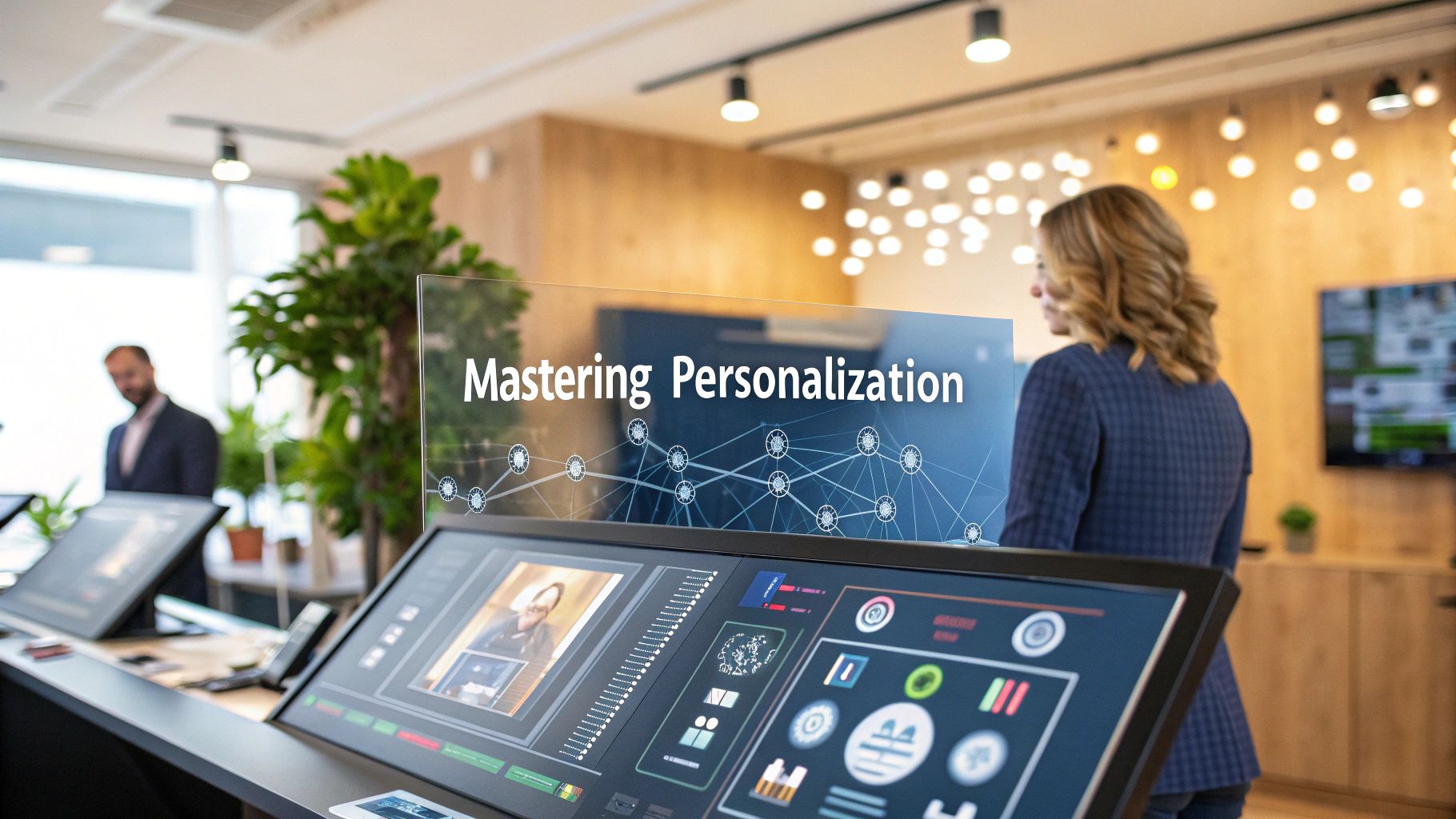
.webp)
.webp)
.webp)





